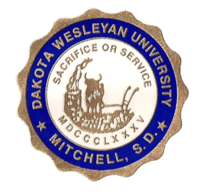Dakota Wesleyan University
 | |
Former names | Dakota University (1885-1904) |
|---|---|
| Motto | Sacrifice or Service |
| Type | Private |
| Established | 1885 |
Religious affiliation | Methodist |
| President | Amy Novak[1] |
| Students | 733 |
| Location | Mitchell, South Dakota, USA |
| Colors | |
| Athletics | NAIA – GPAC |
| Nickname | Tigers |
| Affiliations |
IAMSCU CIC NAICU[2] |
| Website | |
|
Dakota Wesleyan University | |
 | |
| Location | 1200 West University Avenue, Mitchell, South Dakota 57301 (Campus property bounded by McGovern Ave., W. University Ave., Norway Ave., and McCabe St.) |
| Coordinates | 43°41′55″N 98°1′51″W / 43.69861°N 98.03083°WCoordinates: 43°41′55″N 98°1′51″W / 43.69861°N 98.03083°W |
| Built | structures in current use built between 1903 and 2013 |
| Architect | Dow, W.L. (early campus structures) |
| Architectural style | Classical Revival, Other |
| NRHP Reference # | 76001727 |
| Added to NRHP | December 22, 1976[3] |
Dakota Wesleyan University (DWU) is a four-year university located in Mitchell, South Dakota, founded in 1885, which is affiliated with the United Methodist Church. The student body averages slightly fewer than 800 students. The campus of the university is listed on the National Register of Historic Places.
History
In 1883, a small band of Methodist settlers meeting in the Dakota Territory secured a charter to found the college as Dakota University. These pioneers were driven to "build a college of stone while living in houses of sod," and had deep religious convictions about the education and future of their children. They envisioned an institution that epitomized the highest in Christian thought and deed, and so adopted the motto, "Sacrifice or Service". This is symbolized in the collegiate seal of the altar, the ox, and the plow.
On October 14, 1904, the institution assumed its present name of Dakota Wesleyan University.
By 1920, Dakota Wesleyan University was the largest independent college in the state, with an enrollment of more than 300. The Great Depression, which hit the prairie earlier, harder and longer than any region in the nation, evoked another regionally sensitive response from Dakota Wesleyan. The university accepted many students with few or no resources. Lacking adequate tuition revenues, the university and its personnel sacrificed their development and economic well-being in order to provide educational opportunities for students who had no other options. Farm produce was accepted for tuition. As part of their pay, teachers received housing in Graham Hall and coupons to purchase merchandise in town. As in earlier days, the faculty, townspeople and parishioners of the Methodist church sustained the university.
Since the 1930s the university has remained responsive to the special needs of its region. Strong programs in teacher education have provided new teachers for school districts. Nursing and allied health programs address the continuing need for health care professionals in rural South Dakota. In recognition of diverse cultures and traditions in a changing prairie environment, Wesleyan has undertaken a unique and substantial commitment to special programs focusing on Native American culture. Additionally, the university has developed programs to assist students whose previous educational experiences have inadequately prepared them for the demands of a rapidly changing region and future.
The campus was listed on the National Register in 1976.[3][4]
George and Eleanor McGovern Library and Center
Dakota Wesleyan University dedicated the new George and Eleanor McGovern Library and Center for Leadership and Public Service on October 7, 2006. Nearly five thousand people were on hand to hear former President Bill Clinton honor former Senator George McGovern and his wife Eleanor McGovern for their decades of public service and leadership. Other dignitaries who spoke at the dedication include former Senator Tom Daschle, Senator Tim Johnson, Senator John Thune, Representative Stephanie Herseth Sandlin, Governor Mike Rounds, and Al Neuharth, founder of USA Today.
The McGovern Center seeks to prepare Dakota Wesleyan's best students for future leadership and careers in public service through classes, seminars, research, and internships. It also includes the annual McGovern Center Conference, the McGovern Library, and the McGovern Legacy Museum, which gives visitors a look at the lives of the couple. It is also associated with the DWU Tiger Poll which does public opinion polling.
Athletics

Dakota Wesleyan teams, nicknamed athletically as the Tigers, are part of the National Association of Intercollegiate Athletics (NAIA), primarily competing in the Great Plains Athletic Conference (GPAC). They formerly competed in the South Dakota Intercollegiate Conference (SDIC). Men's sports include baseball, basketball, cheerleading, cross country, football, golf, soccer, track & field and wrestling; while women's sports include basketball, cheerleading, cross country, golf, soccer, softball, track & field and volleyball. In 2015, the men's basketball team won runner-up in the 2015 NAIA Division II Men's Basketball Tournament.
Notable alumni
- Harlan J. Bushfield, 16th Governor of South Dakota and as a United States Senator[5]
- George Theodore Mickelson, former Governor of South Dakota
- George McGovern, former U.S. Congressman, U.S. Senator, and Democratic Party presidential candidate
- Francis Case, former U.S. Congressman from South Dakota.
- Clinton Presba Anderson, former U.S. Secretary of Agriculture, former U.S. Senator and U.S. Congressman from New Mexico
- Stanley Hallett, American urban planner and neighborhood advocate
- Kevin A. Casey, writer, musician, and humorist
- Ed Meierkort, former head coach of the South Dakota Coyotes football team
- Brett Abbotts, professional golfer, Dakotas Tour
- Benjamin Daniel Jukich, professional baseball pitcher[6]
References
- ↑ "Novak named president at DWU". April 18, 2013. Archived from the original on December 30, 2014.
- ↑ NAICU – Member Directory
- 1 2 Staff (2008-04-15). "National Register Information System". National Register of Historic Places. National Park Service.
- ↑ Note: A National Register of Historic Places Inventory-Nomination document should be available upon request from the National Park Service for this site, but it appears not to be available on-line from the NPS Focus search site.
- ↑ "Harlan J. Bushfield". National Governors Association. Retrieved 2 September 2012.
- ↑ Dakota Wesleyan University, Athletics Department. "Baseball Stats and History" (PDF). Dakota Wesleyan University.
External links
| Wikimedia Commons has media related to Dakota Wesleyan University. |
- Official website
- Dakota Wesleyan University Athletics Website
- McGovern Center
- George and Eleanor McGovern Library
- DWU Student Senate
- Dakota Wesleyan University at National Center for Education Statistics: College Navigator
| ||||||||||||||||||||||||||||||||||||||||||||||||||
| ||||||||||||||||||||||||||
| ||||||
| ||||||||||||||||||||||||||||||
